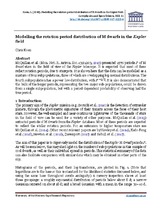| dc.contributor.author | Koen, Chris | |
| dc.date.accessioned | 2018-01-04T10:31:48Z | |
| dc.date.available | 2018-01-04T10:31:48Z | |
| dc.date.issued | 2018 | |
| dc.identifier.citation | Koen, C. (2018). Modelling the rotation period distribution of M dwarfs in the Kepler field. Astrophysics and Space Science, 363: 11 | en_US |
| dc.identifier.issn | 0004-640X | |
| dc.identifier.uri | http://dx.doi.org/10.1007/s10509-017-3225-6 | |
| dc.identifier.uri | http://hdl.handle.net/10566/3348 | |
| dc.description.abstract | McQuillan et al. (Mon. Not. R. Astron. Soc.432:1203, 2013) presented 1570 periods P of M dwarf stars in the field of view of the Kepler telescope. It is expected that most of these reflect rotation periods, due to starspots. It is shown here that the data can be modelled as a mixture of four subpopulations, three of which are overlapping log-normal distributions. The fourth subpopulation has a power law distribution, with P −1/2. It is also demonstrated that the bulk of the longer periods, representing the two major sub-populations, could be drawn from a single subpopulation, but with a period-dependent probability of observing half the true period. | en_US |
| dc.language.iso | en | en_US |
| dc.publisher | Springer Verlag | en_US |
| dc.rights | This is the author-version of the article published online at: http://dx.doi.org/10.1007/s10509-017-3225-6 | |
| dc.subject | Statistical methods | en_US |
| dc.subject | Stars | en_US |
| dc.subject | Rotation | en_US |
| dc.subject | Starspots | en_US |
| dc.title | Modelling the rotation period distribution of M dwarfs in the Kepler field | en_US |
| dc.type | Article | en_US |
| dc.privacy.showsubmitter | FALSE | |
| dc.status.ispeerreviewed | TRUE | |

